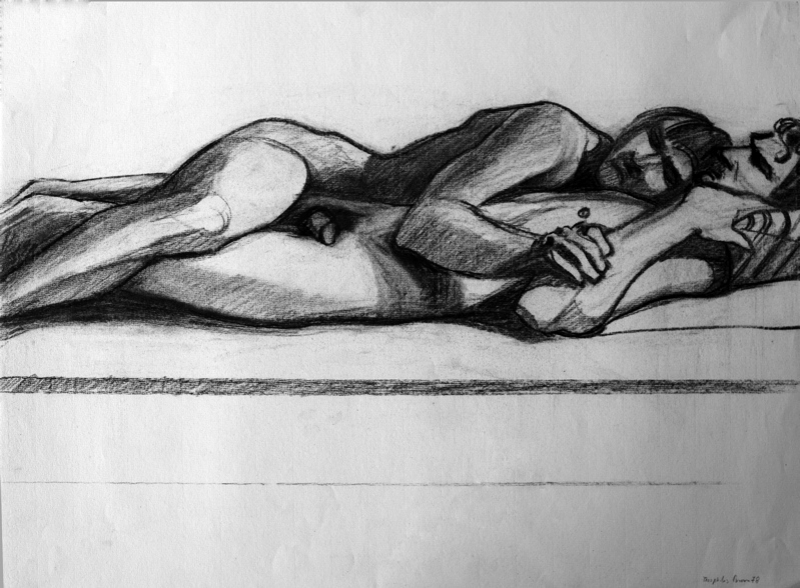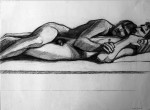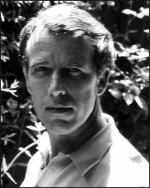Whitehot Magazine
September 2025
"The Best Art In The World"
"The Best Art In The World"
September 2025
May 2009, Theophilus Brown @ ArtHouse Gallery

Theophilus Brown: Five Decades of Rendering the Male Nude at ArtHouse Gallery
McAllen, Texas
1001 S. 16th St.
McAllen, Texas 78505
Theophilus Brown: Five Decades of Rendering the Male Nude provides an opportunity to access a little know yet historically important body of work by a practicing artist who recently turned 90 years old.
The exhibition of male nudes - shown here for the first time ever - functions as a revisionist project, as the full art historical importance of Theophilus Brown is still largely unacknowledged. This is due, perhaps, to the propensity of art history to be written as a sequence of successive styles. Brown worked primarily in the San Francisco Bay Area when New York was considered the art capital, and he chose to follow his own vision rather than mimic artistic trends. There is also a lack of public exposure to, and familiarity with, the depth and breadth of his artistic production. Furthermore, artists of a certain age, regardless of how active they are, tend to be situated in the past and are judged by what they have done instead of what they are currently doing.
The exhibit also serves as an interesting example of how ideas, no matter how historically distant or diverse, are inherited and embodied in personal artistic visions. By extension, it exemplifies how the past is bridged to the present in order to inform specific artistic needs and desires.
It is true that much of Theophilus Brown’s significance can be anchored in the past due to his associations with modern composers such as John Cage and Igor Stravinsky (he studied music at Yale University, graduating in 1941), and with artists he met in Paris after serving in World War II and relocating on the G.I. Bill. These included Pablo Picasso, Georges Braque and Alberto Giacometti. After moving back to New York In 1949, he established ties with American artists Philip Guston and Mark Rothko, and a close and lasting friendship with Willem and Elaine de Kooning who strongly influenced his work. Brown also played an integral role in developing the San Francisco Bay Area Figurative Art movement. This particular connection informs the choice of subjects, images, and techniques used in the nudes currently on view.
In this context, Brown’s images reference not only Bay Area figuration, but also a long tradition that alludes to Classical Greek sculpture and its concern for representing idealized human anatomy with harmonious proportions. His work also references the Renaissance academic tradition that considered figure drawing and rendering nudes to be the core component of canonical art. Anatomical studies of the figure, gesture drawing, and concern with proportion formed the basic components of artistic education, and eventually lead to early modernist abstractions of the figure.
The reintegration of the human form by Bay Area Figurative artists generalized figures without necessarily particularizing their identities, so that the personal features of a subject or model were subsumed in the rendering of the human form. Though Brown’s works refer to this practice, in many cases the aesthetic strategy is inverted so that any allusion that would suggest “male” as a generalized abstract form is evoked by the particularity of his models/subjects. It is through his subjects’ diversity and specificity that the individuals represented are capable of evoking or bringing to mind something larger: a concept of “male.” The nebulousness of Brown’s artistic intention, formal strategies, and variety of depictions, create the ability to stimulate varied audience responses, free associations, and interpretations. This strategy simultaneously brings to mind and disrupts “male” as an overarching unitary category.
In this exhibit, what becomes evident and central is how the representation of “male” as a subject can be a highly charged identification. It is here constituted through individual, specific, and differentiated representations, through various poses, postures, textures and colors, and through body language that viewers can recognize but not grasp with any degree of certainty. This specificity expands and confounds the individual meanings of the works. The works both partake of and contribute to ideologies centered in the idealization of the human form, as well as mythologies of an essential nature of men as ‘other’ and opposite beings in relation to women.
If Brown’s preference for the male figure has developed into a personal or recognizable style that speaks to continuity, this perhaps emerges from his pleasure in representing his subjects. It could also be attributed his formal explorations of proportion and gesture, and the underlying compositional interconnections formed through the fusion of abstraction and figuration. All this links these pieces with his other diverse bodies of work, such as his outdoor reveries, urban and industrial landscapes, portraits and self-portraits. It furthermore reveals an ongoing artistic concern for integrating shapes, and balancing illumination and compositional structures across different media, content, and genres. Brown has an obvious appreciation for subtlety and refinement in gestural application and surface values. His use of line and shading, and his juxtaposition of volumes reveals an economic handling of integrated objects represented in pictorial space.
Also of extreme importance is the possibility that the true subject of these works lies beyond the images depicted. It may be that the artist’s ability to skillfully manipulate the materials and tools at his disposal, as well as his knowledge - clearly informed by lessons learned over years of artistic practice - constitutes the real content of the work.
In the end, the aesthetic strategies apparent in Five Decades of Rendering the Male Nude speak not only to the profound significance of these works as art historical documents, but additionally to Theophilus Brown’s monumental commitment over the years to exploring a variety of aesthetic pursuits. His work has been a means of translating personal experiences while addressing artistic challenges in order comment on the complexity of our shared cultural existences.

Anthony Torres
Anthony Torres is an independent scholar, art writer, and art appraiser. He has curated and traveled numerous exhibitions, and published extensively in Artweek, New Art Examiner, Art Papers and others. Additionally he researched and wrote the “Illustrated Chronology” and essay “Negotiating Space: The Sketch Books,” for the book, Frank Lobdell: The Art of Making and Meaning (2003).
Follow Whitehot on Instagram
Visit our postings and listings section
view all articles from this author













